Relating Building Management to Our Common Air, Energy Resources
Part 3 of a 4-part article from the U.S. Green Building Council
So what do sustainable fish harvests and a sustainability game have to do with managing buildings? A lot. Buildings use a great deal of energy and the majority of that energy is based on electricity generated with fossil fuels. Fossil fuels when burned emit carbon dioxide, an air pollutant and major factor in causing climate change. Understanding building energy use in the context of the commons – our air and energy resources — could be a helpful way to explain why energy efficiency and the transition to renewable energy sources are so important.
The September/October issue of Mother Jones published an article on “the hidden costs of dirty energy,” and illustrated the following findings based on research by the International Monetary Fund: The external (unaccounted for) cost of coal is by far more than that of oil and natural gas due primarily to air pollution and global warming impact. The external cost of coal is more than $3 trillion per year versus about $1.4 trillion for oil (with traffic accidents being the highest cost) and less than $0.5 trillion for natural gas. All of these estimated “costs” are borne by the commons and add up to the equivalent of over $5 trillion per year, 33 percent more than the U.S. federal budget. According to the U.S. Energy Information Administration, 39 percent of U.S. electricity is generated by coal, 27 percent by natural gas, and 1 percent by petroleum. (Non-fossil-fuel energy sources include 7 percent in various renewable sources, not including hydro, which itself provides 6 percent, or nuclear at 19 percent.)
Per the Global Footprint Network, humanity reached Earth’s “Overshoot Day” on August 13, 2015. “Global overshoot occurs when humanity’s annual demand for the goods and services that our land and seas can provide — fruits and vegetables, meat, fish, wood, cotton for clothing, carbon dioxide absorption, etc. — exceeds what Earth’s ecosystems can renew in a year. Overshoot means we are drawing down the planet’s principal rather than living off its annual interest.”
These concepts, the “tragedy of the commons” and “overshoot day,” provide useful frameworks for addressing humanity’s use of common resources. The good news is that there are things that all humanity can do, and that facility managers can do. Most important is to consider how energy is being used and to dramatically reduce consumption of fossil-fuel-generated electricity.
While energy efficiency has been a practice that most facility managers have worked with for years, we have to do better. Much has been written about net-zero energy buildings, and this is clearly a worthy goal. However, it is not easy to accomplish with most existing buildings, unless the building owner also has an interest in a nearby solar (photovoltaic) array. Most buildings could consider the efficiency and economic benefits, as well as the potential building improvement benefits, of a “deep retrofit.” An excellent example of how a deep retrofit can add significant benefit is the energy efficiency renovation at the Empire State Building.
A deep retrofit includes consideration of all energy-consuming systems interacting with each other, including the building envelope (windows, insulation), lighting, and HVAC systems. In a deep retrofit, it may pay to spend a lot of extra money on super-insulating windows, significantly increased wall insulation, and well-designed controllable lighting. The resulting smaller building loads lead to significantly smaller HVAC loads, resulting in the potential elimination of systems as well as the installation of smaller systems, helping to pay for the increased insulation. As a bonus, big reductions in energy costs result in significantly higher net operating income, which increases building value.
Understanding that we live in an interconnected world and humanity’s impact on the commons helps frame the issues we face and begins to show how our actions make a difference. Thus, it’s time to ask ourselves, what can we do as role models and leaders to avoid the tragedy of the commons? What are the eco-system services that we use and how can we make sure they are available for future generations?
Helen J. Kessler, FAIA, LEED Fellow is president of HJKessler Associates, a green building and sustainability consulting firm in Chicago. Email her at hjkessler@hjkesslerassociates.com.
Related Topics:














